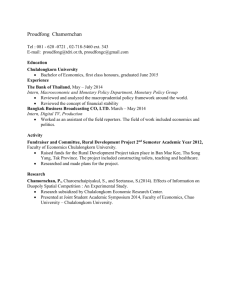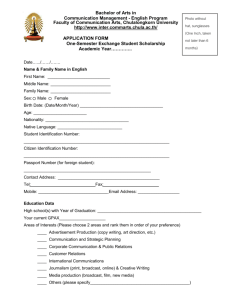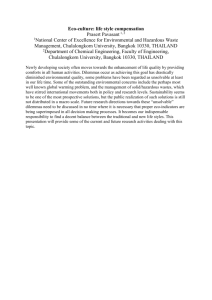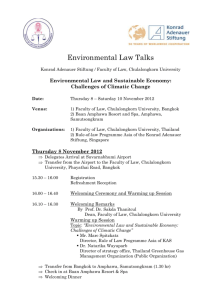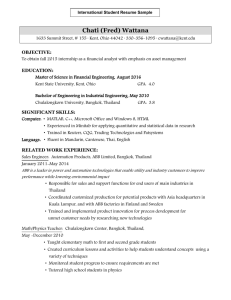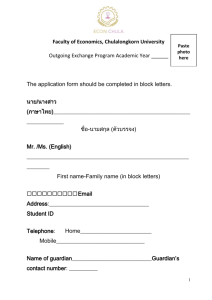Statistics for Language Teachers Kanchana prapphal May 23, 2002 Kasetsart University
advertisement
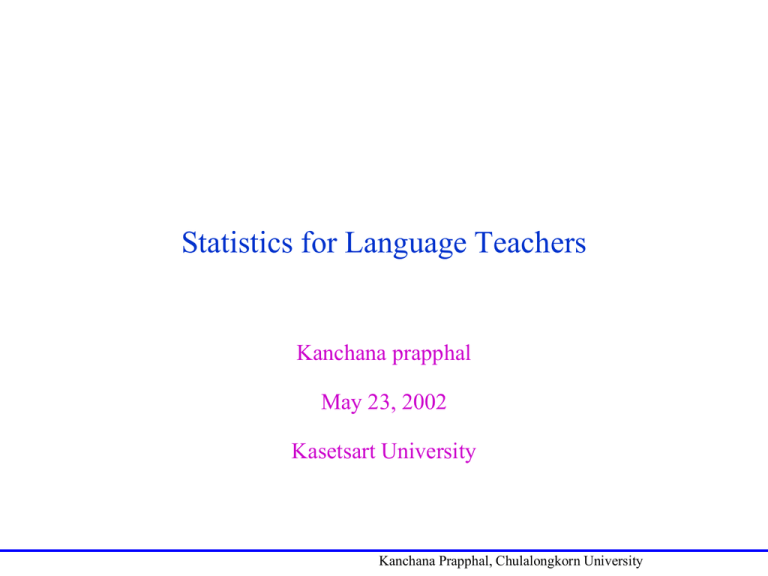
Statistics for Language Teachers Kanchana prapphal May 23, 2002 Kasetsart University Kanchana Prapphal, Chulalongkorn University Contents • Descriptive Statistics (Frequency Distributions, Measures of Central Tendency, Measures of Variability) • Correlation and Regression • Inferential Statistics (t-test, F-test) • Non-parametric Statistical Tests (Chi-square Test, Spearman Rank Order Correlation) Kanchana Prapphal, Chulalongkorn University Frequency Distributions • Class interval • Graphic Presentation of Data (Bar graph, Histogram, Frequency Polygon, Line graph) • Percentage 100 80 60 East 40 West 20 North 0 1st Qtr 2nd Qtr 3rd Qtr 4th Qtr Kanchana Prapphal, Chulalongkorn University Measures of Central Tendency • Mode • Median • Arithmetic mean (X = sum X/N) Kanchana Prapphal, Chulalongkorn University Measures of Variability • • • • Range Variance Standard deviation The normal distribution Kanchana Prapphal, Chulalongkorn University Correlation • Relationship between 2 variables • Interpretation: • +.95, +.93, +.87, +.85 = high positive correlation • +.23, +.20, +.18, +.17 = low positive correlation • +.02, +.01, .00, -.03 = no systematic correlation • -.21, -.22, -.17, -.19 = low negative correlation • -.92, -.89, -.90, -.93 = high negative correlation Kanchana Prapphal, Chulalongkorn University Pearson Correlation Matrix • ________________________________ ___________ • Tests 1 2 3 • ________________________________ ___________ • 1. Vocab 1.000 .38 .66 • 2. Grammar 1.00 .60 • 3. Sound Perception 1.00 Kanchana Prapphal, Chulalongkorn University Regression (Bivariate) • Prediction of the relationship between 2 variables • y = a + bx • y = the predicted college GPA • a = constant or the point at which the regression line intersects the y axis • b = the slope of the regression line,I.e. the amount of y is increasing for each increase of one unit in x • x = the x value used to predict y Kanchana Prapphal, Chulalongkorn University Regression (Multiple Variables) • • • • • • • Multiple regression prediction equation y = a + bx1 + bx2 + bx3 y = the predicted college GPA x1 = the high school GPA x2 = the score on the entrance exam x3 = the absence rate in high school y = 2.80 = He would be predicted to obtain a B- average in his first quarter of college work. Kanchana Prapphal, Chulalongkorn University Inferential Statistics • T-test (independent samples, correlated samples) • F-test • One-way analysis of variance (ANOVA) • Factorial analysis of variance • -two-way ANOVA • -three-way ANOVA • -factorial design Kanchana Prapphal, Chulalongkorn University T-test (for one factor with 2 groups) • A. Independent samples e.g. • An experiment between a control group and an experimental group • B. Dependent or correlated samples e.g. • The difference between the pre-test and the post-test Kanchana Prapphal, Chulalongkorn University F-test • One-way ANOVA (with more than two groups) • The ANOVA Summary Table • Source df SS MS F • Test formats 2 16 8 4* • Within groups 15 30 2 • Total 17 46 • *p < .05 • The three groups differed in terms of the test form they received. Kanchana Prapphal, Chulalongkorn University Two-Way ANOVA • 3 Fs • 2 main effects (two factors or two independent variables) • 1 interaction (the effect the dependent variable of the two independent variables operating together) • Example: an experiment of two methods of teaching English Kanchana Prapphal, Chulalongkorn University Three-Way ANOVA • • • • • 7Fs 3 main effects 3 first-order interactions (AxB, AxC, BxC) 1 second-order interaction (AxBxC) Example: an experiment on three methods of teaching English Kanchana Prapphal, Chulalongkorn University Factorial Design • • • • • • More than one factor Two main effects and one interaction Example: Factors = Time limit (Yes, No) Item order (syllabus, backward, random) 2*3 ANOVA Kanchana Prapphal, Chulalongkorn University Non-parametric Statistical Tests • Chi-square Test • frequency, category, nominal data • Spearman Rank Order Correlation • rank, N < 30, ordinal data Kanchana Prapphal, Chulalongkorn University Practice • • • • • • • tests mean % sd items structure 31.57 (42.09) 15.05 75 listening 19.33 (38.66) 8.43 50 CU-TEP 44.54 (44.54) 16.36 100 Which is the easiest test? Which is the most difficult test? What do you learn from the standard deviations of the 3 tests? Kanchana Prapphal, Chulalongkorn University Practice (continued) • Interpret the following correlation coefficients. • Structure Listening CU-TEP Spelling • Structure .723** .560 * -.300* • Listening .840 ** -.010 • Spelling • *p< .05 **p< .01 Kanchana Prapphal, Chulalongkorn University Practice (continued) • Read the following table. • Criterion variables R • Aptitude Aptitude+Affective F • Reading .792 .810 6.094** • Listening .723 .740 3.200** • Writing .570 .608 5.111** • Speaking .578 .624 6.182** Kanchana Prapphal, Chulalongkorn University Practice (continued) • • • • • • • • Source df Instructional methods (A) 1 Subject matters (B) 1 Science interest levels (C) 1 AxB 1 AxC 1 BxC 1 AxBxC 1 MS F 439.35 4.85* 67.33 1.13 1116.94 12.34** 111.83 225.92 760.03 8.39*** Kanchana Prapphal, Chulalongkorn University Research Questions • • • • Is there a significant relationship between X and Y? Do A, B, and C have any effect on Y? Which method (A or B) is better for first-year Arts students? Can field trips, case studies and mini-theses predict career success of graduate students? Kanchana Prapphal, Chulalongkorn University Kanchana Prapphal, Chulalongkorn University
